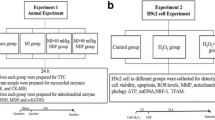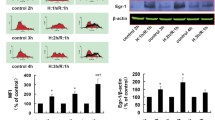Abstract
Cardiovascular disease is the deadliest disease in the world. Previous studies have shown that Dihydrotanshinone I (DHT) can improve cardiac function after myocardial injury. This study aimed to observe the protective effect and mechanism of DHT on H9c2 cells by establishing an oxygen–glucose deprivation/reoxygenation (OGD/R) injury model. By constructing OGD/R injury simulation of H9c2 cells in a myocardial injury model, the proliferation of H9c2 cells treated with DHT concentrations of 0.1 μmol/L were not affected at 24, 48, and 72 h. DHT can significantly reduce the apoptosis of H9c2 cells caused by OGD/R. Compared with the OGD/R group, DHT treatment significantly reduced the level of MDA and increased the level of SOD in cells. DHT treatment of cells can significantly reduce the levels of ROS and Superoxide in mitochondria in H9c2 cells caused by OGD/R and H2O2. DHT significantly reduced the phosphorylation levels of P38MAPK and ERK in H9c2 cells induced by OGD/R, and significantly increased the phosphorylation levels of AKT in H9c2 cells. DHT can significantly reduce the oxidative stress damage of H9c2 cells caused by H2O2 and OGD/R, thereby reducing the apoptosis of H9c2 cells. And this may be related to regulating the phosphorylation levels of AKT, ERK, and P38MAPK.






Similar content being viewed by others
References
Berg K, Jynge P, Bjerve K, Skarra S, Basu S, Wiseth R (2005) Oxidative stress and inflammatory response during and following coronary interventions for acute myocardial infarction. Free Radic Res 39:629–636
Boyle EM Jr, Canty TG Jr, Morgan EN, Yun W, Pohlman TH, Verrier ED (1999) Treating myocardial ischemia-reperfusion injury by targeting endothelial cell transcription. Ann Thorac Surg 68:1949–1953
Breiteneder-Geleff S, Matsui K, Soleiman A, Meraner P, Poczewski H, Kalt R, Schaffner G, Kerjaschki D (1997) Podoplanin, novel 43-kd membrane protein of glomerular epithelial cells, is down-regulated in puromycin nephrosis. Am J Pathol 151:1141–1152
Bulluck H, Yellon DM, Hausenloy DJ (2016) Reducing myocardial infarct size: Challenges and future opportunities. Heart 102:341–348
Chen X, Yu J, Zhong B, Lu J, Lu JJ, Li S, Lu Y (2019) Pharmacological activities of dihydrotanshinone I, a natural product from salvia miltiorrhiza bunge. Pharmacol Res 145:104254
Clerk A, Fuller SJ, Michael A, Sugden PH (1998) Stimulation of “stress-regulated” mitogen-activated protein kinases (stress-activated protein kinases/c-Jun N-terminal kinases and p38-mitogen-activated protein kinases) in perfused rat hearts by oxidative and other stresses. J Biol Chem 273:7228–7234
Cory S, Adams JM (2002) The Bcl2 family: regulators of the cellular life-or-death switch. Nat Rev Cancer 2:647–656
Elsasser A, Suzuki K, Lorenz-Meyer S, Bode C, Schaper J (2001) The role of apoptosis in myocardial ischemia: A critical appraisal. Basic Res Cardiol 96:219–226
Farias JG, Molina VM, Carrasco RA, Zepeda AB, Figueroa E, Letelier P, Castillo RL (2017) Antioxidant therapeutic strategies for cardiovascular conditions associated with oxidative stress. Nutrients 9:966
Ferdinandy P, Hausenloy DJ, Heusch G, Baxter GF, Schulz R (2014) Interaction of risk factors, comorbidities, and comedications with ischemia/reperfusion injury and cardioprotection by preconditioning, postconditioning, and remote conditioning. Pharmacol Rev 66:1142–1174
Frank A, Bonney M, Bonney S, Weitzel L, Koeppen M, Eckle T (2012) Myocardial ischemia reperfusion injury: From basic science to clinical bedside. Semin Cardiothorac Vasc Anesth 16:123–132
Garcia-Echeverria C, Sellers WR (2008) Drug discovery approaches targeting the PI3K/Akt pathway in cancer. Oncogene 27:5511–5526
Goldhaber JI, Weiss JN (1992) Oxygen free radicals and cardiac reperfusion abnormalities. Hypertension 20:118–127
Gonzalez MC, Marteau C, Franchi J, Migliore-Samour D (2001) Cytochrome P450 4A11 expression in human keratinocytes: Effects of ultraviolet irradiation. Br J Dermatol 145:749–757
Haunstetter A, Izumo S (1998) Apoptosis: basic mechanisms and implications for cardiovascular disease. Circ Res 82:1111–1129
Jiang L, Zeng H, Ni L, Qi L, Xu Y, Xia L, Yu Y, Liu B, Yang H, Hao H, Li P (2019) HIF-1alpha preconditioning potentiates antioxidant activity in ischemic injury: The role of sequential Administration of Dihydrotanshinone I and Protocatechuic Aldehyde in cardioprotection. Antioxid Redox Signal 31:227–242
Kevin LG, Camara AK, Riess ML, Novalija E, Stowe DF (2003a) Ischemic preconditioning alters real-time measure of O2 radicals in intact hearts with ischemia and reperfusion. Am J Physiol Heart Circ Physiol 284:H566-574
Kevin LG, Novalija E, Riess ML, Camara AKS, Rhodes SS, Stowe DF (2003b) Sevoflurane exposure generates superoxide but leads to decreased superoxide during ischemia and reperfusion in isolated hearts. Anesth Analg 96:949–955
Kim SL, Choi HS, Kim JH, Jeong DK, Kim KS, Lee DS (2019) Dihydrotanshinone-induced NOX5 activation inhibits breast cancer stem cell through the ROS/Stat3 signaling pathway. Oxid Med Cell Longev 2019:9296439
Lam FF, Yeung JH, Chan KM, Or PM (2008) Dihydrotanshinone, a lipophilic component of salvia miltiorrhiza (danshen), relaxes rat coronary artery by inhibition of calcium channels. J Ethnopharmacol 119:318–321
Levraut J, Iwase H, Shao ZH, Vanden Hoek TL, Schumacker PT (2003) Cell death during ischemia: Relationship to mitochondrial depolarization and ROS generation. Am J Physiol Heart Circ Physiol 284:H549-558
Li H, Zhu J, Xu YW, Mou FF, Shan XL, Wang QL, Liu BN, Ning K, Liu JJ, Wang YC et al (2022) Notoginsenoside R1-loaded mesoporous silica nanoparticles targeting the site of injury through inflammatory cells improves heart repair after myocardial infarction. Redox Biol 54:102384
Li ZM, Xu SW, Liu PQ (2018) Salvia miltiorrhizaBurge (Danshen): A golden herbal medicine in cardiovascular therapeutics. Acta Pharmacol Sin 39:802–824
Liu Q, Zhang Y, Lin Z, Shen H, Chen L, Hu L, Jiang H, Shen X (2010) Danshen extract 15,16-dihydrotanshinone I functions as a potential modulator against metabolic syndrome through multi-target pathways. J Steroid Biochem Mol Biol 120:155–163
Qin F, Shite J, Mao W, Liang CS (2003) Selegiline attenuates cardiac oxidative stress and apoptosis in heart failure: Association with improvement of cardiac function. Eur J Pharmacol 461:149–158
Saraste A, Pulkki K, Kallajoki M, Henriksen K, Parvinen M, Voipio-Pulkki LM (1997) Apoptosis in human acute myocardial infarction. Circulation 95:320–323
Su CY, Ming QL, Rahman K, Han T, Qin LP (2015) Salvia miltiorrhiza: Traditional medicinal uses, chemistry, and pharmacology. Chin J Nat Med 13:163–182
Vanden Hoek TL, Li C, Shao Z, Schumacker PT, Becker LB (1997) Significant levels of oxidants are generated by isolated cardiomyocytes during ischemia prior to reperfusion. J Mol Cell Cardiol 29:2571–2583
Veinot JP, Gattinger DA, Fliss H (1997) Early apoptosis in human myocardial infarcts. Hum Pathol 28:485–492
Wang L, Ma R, Liu C, Liu H, Zhu R, Guo S, Tang M, Li Y, Niu J, Fu M et al (2017) Salvia miltiorrhiza: A potential red light to the development of cardiovascular diseases. Curr Pharm Des 23:1077–1097
Wang X, Martindale JL, Liu Y, Holbrook NJ (1998) The cellular response to oxidative stress: Influences of mitogen-activated protein kinase signalling pathways on cell survival. Biochem J 333(Pt 2):291–300
Wang YC, Wang H, Shao CL, Li XY, Cui J, Guo HD (2023) Screening and identification of effective components from modified taohong siwu decoction for protecting H9c2 cells from damage. In Vitro Cell Dev Biol Anim 59:346–355
Wei Y, Xu M, Ren Y, Lu G, Xu Y, Song Y, Ji H (2016) The cardioprotection of dihydrotanshinone I against myocardial ischemia-reperfusion injury via inhibition of arachidonic acid omega-hydroxylase. Can J Physiol Pharmacol 94:1267–1275
Yue TL, Wang C, Gu JL, Ma XL, Kumar S, Lee JC, Feuerstein GZ, Thomas H, Maleeff B, Ohlstein EH (2000) Inhibition of extracellular signal-regulated kinase enhances Ischemia/Reoxygenation-induced apoptosis in cultured cardiac myocytes and exaggerates reperfusion injury in isolated perfused heart. Circ Res 86:692–699
Zhang P, Liu MC, Cheng L, Liang M, Ji HL, Fu J (2009) Blockade of LOX-1 prevents endotoxin-induced acute lung inflammation and injury in mice. J Innate Immun 1:358–365
Zhao W, Li C, Gao H, Wu Q, Shi J, Chen X (2016) Dihydrotanshinone I attenuates atherosclerosis in ApoE-deficient mice: Role of NOX4/NF-kappaB mediated lectin-like oxidized LDL Receptor-1 (LOX-1) of the endothelium. Front Pharmacol 7:418
Zweier JL, Rayburn BK, Flaherty JT, Weisfeldt ML (1987) Recombinant superoxide dismutase reduces oxygen free radical concentrations in reperfused myocardium. J Clin Invest 80:1728–1734
Funding
This work was supported by grants from the National Natural Science Foundation of China (82174120, 81970991, 82104430, 82204831), Natural Science Foundation of Shanghai (No. 21ZR1463100), Program of Shanghai Academic Research Leader (22XD1423400) and Shanghai Sailing Program (No. 21YF1447600).
Author information
Authors and Affiliations
Corresponding authors
Ethics declarations
Conflict of interest
The authors declare that the research was conducted in the absence of any commercial or financial relationships that could be construed as a potential conflict of interest.
Rights and permissions
Springer Nature or its licensor (e.g. a society or other partner) holds exclusive rights to this article under a publishing agreement with the author(s) or other rightsholder(s); author self-archiving of the accepted manuscript version of this article is solely governed by the terms of such publishing agreement and applicable law.
About this article
Cite this article
Wang, Yc., Shao, Yd., Shao, Cl. et al. Dihydrotanshinone I reduces H9c2 cell damage by regulating AKT and MAPK signaling pathways. In Vitro Cell.Dev.Biol.-Animal 60, 89–97 (2024). https://doi.org/10.1007/s11626-023-00839-2
Received:
Accepted:
Published:
Issue Date:
DOI: https://doi.org/10.1007/s11626-023-00839-2




